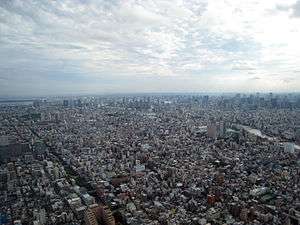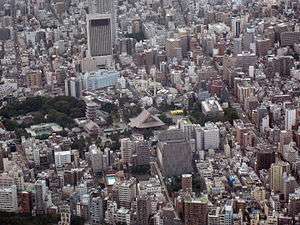Tokyo Skytree
| Tokyo Skytree | |
|---|---|
| 東京スカイツリー | |
 | |
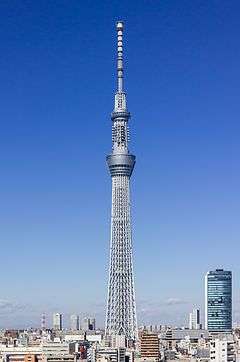 Tokyo Skytree in 2014 | |
| General information | |
| Status | Complete |
| Type | Broadcast, restaurant, and observation tower |
| Architectural style | Neofuturistic |
| Location | Sumida, Tokyo, Japan |
| Coordinates | 35°42′36.5″N 139°48′39″E / 35.710139°N 139.81083°ECoordinates: 35°42′36.5″N 139°48′39″E / 35.710139°N 139.81083°E |
| Construction started | 14 July 2008 |
| Completed | 29 February 2012 |
| Opening | 22 May 2012 |
| Cost | 65 billion JPY (806 million USD)[1] |
| Owner | Tobu Tower Skytree Co., Ltd. |
| Height | |
| Antenna spire | 634.0 m (2,080 ft) |
| Roof | 495.0 m (1,624 ft) |
| Top floor | 451.2 m (1,480 ft) |
| Technical details | |
| Floor count |
32 above ground[2] 3 below ground[2] |
| Lifts/elevators | 13 |
| Design and construction | |
| Architect | Nikken Sekkei |
| Developer | Tobu Railway |
| Main contractor | Obayashi Corp. |
| Website | |
|
www | |
Tokyo Skytree (東京スカイツリー Tōkyō Sukaitsurī) is a broadcasting, restaurant, and observation tower in Sumida, Tokyo, Japan. It became the tallest structure in Japan in 2010[3] and reached its full height of 634.0 metres (2,080 ft) in March 2011, making it the tallest tower in the world, displacing the Canton Tower,[4][5] and the second tallest structure in the world after the Burj Khalifa (829.8 m/2,722 ft).[6]
The tower is the primary television and radio broadcast site for the Kantō region; the older Tokyo Tower no longer gives complete digital terrestrial television broadcasting coverage because it is surrounded by high-rise buildings. Skytree was completed on 29 February 2012, with the tower opening to the public on 22 May 2012.[7] The tower is the centrepiece of a large commercial development funded by Tobu Railway and a group of six terrestrial broadcasters headed by NHK. Trains stop at the adjacent Tokyo Skytree Station and nearby Oshiage Station. The complex is 7 km (4.3 mi) north-east of Tokyo Station.
Design
The design was published on 24 November 2006,[8] based on the following three concepts:
- Fusion of neofuturistic[9][10] design and the traditional beauty of Japan,
- Catalyst for revitalization of the city,
- Contribution to disaster prevention – "Safety and Security".
The base of the tower has a structure similar to a tripod; from a height of about 350 m (1,150 ft) and above, the tower's structure is cylindrical to offer panoramic views of the river and the city.[11] There are observatories at 350 m (1,150 ft), with a capacity of up to 2000 people, and 450 m (1,480 ft), with a capacity of 900 people.[12] The upper observatory features a spiral, glass-covered skywalk in which visitors ascend the last 5 meters to the highest point at the upper platform. A section of glass flooring gives visitors a direct downward view of the streets below.[13]
Earthquake resistance
The tower has seismic proofing, including a central shaft made of reinforced concrete. The main internal pillar is attached to the outer tower structure for the first 125 meters (410 ft) above ground. From there until 375 meters (1,230 ft) the pillar is attached to the tower frame with oil dampers, which act as cushions during an earthquake. Additional resilience is achieved through an "added mass control mechanism" (or tuned mass damper) - a damping system which, in the event of an earthquake, moves out of step with the building's structure, to keep the center of gravity as central as possible to the tower's base.[14] According to the designers, the dampers can absorb 50 percent of the energy from an earthquake.[15][16]
Colour
The exterior lattice is painted a colour officially called "Skytree White". This is an original colour based on a bluish white traditional Japanese colour called aijiro (藍白).[17]
Illumination
The illumination design was published on 16 October 2009. Two illumination patterns Iki (chic, stylish) sky blue and Miyabi (elegance, refinement) purple will be used, alternating daily. The tower is illuminated using LED lights.[18]
Naming and height

From October to November 2007, suggestions were collected from the general public for the name to be given to the tower. On 19 March 2008, a committee chose six final candidate names: Tōkyō Sukaitsurī (東京スカイツリー, "Tokyo sky tree"), Tōkyō Edo Tawā (東京EDOタワー, "Tokyo Edo tower"), Raijingu Tawā (ライジングタワー, "Rising tower"), Mirai Tawā (みらいタワー, "Tower of the future"), Yumemi Yagura (ゆめみやぐら, "Dream lookout"), Raijingu Īsuto Tawā (ライジングイーストタワー, "Rising east tower"). The official name was decided in a nationwide vote, and was announced on 10 June 2008 as "Tokyo Skytree". The name received around 33,000 votes (30%) out of 110,000 cast, with the second most popular name being "Tokyo Edo Tower".[19]
Since the name was decided in Japanese, which has no spaces between words, it is not possible to say whether it was intended to be "Tokyo Skytree" or "Tokyo Sky Tree". The official website states "TOKYO SKYTREE" (all caps) as a registered trademark in English, but the version in the logo is clearly "SKY TREE". English-language publications are divided between the two versions.
The height of 634 m (2,080 ft) was selected to be easily remembered. The figures 6 (mu), 3 (sa), 4 (shi) stand for "Musashi", an old name of the region where the Tokyo Skytree stands.[20]
Broadcasting use
Tokyo Skytree is used as a radio/television broadcast and communications tower.
Television broadcasters
| Channel | Channel name | Callsign | Signal power | ERP | Broadcast area |
|---|---|---|---|---|---|
| |
NHK General TV | JOAK-DTV | 10 kW | 68 kW | Kantō region |
| |
NHK Educational TV | JOAB-DTV | |||
| |
Nippon Television | JOAX-DTV | |||
| |
TV Asahi | JOEX-DTV | |||
| |
TBS Television | JORX-DTV | |||
| |
TV Tokyo | JOTX-DTV | |||
| |
Fuji Television | JOCX-DTV | |||
| |
TOKYO MX | JOMX-DTV | 3 kW | 11.5 kW | Tokyo |
Radio broadcasters
| Frequency | Station name | Callsign | Power | ERP | Broadcast area |
|---|---|---|---|---|---|
| 81.3 MHz | J-Wave Tokyo | JOAV-FM | 7 kW | 57 kW | Tokyo |
| 82.5 MHz | NHK FM Broadcast Tokyo | JOAK-FM | |||
| 90.5 MHz | TBS Radio Sumida | South Kantō region | |||
| 91.6 MHz | Nippon Cultural Broadcasting Sumida | ||||
| 93.0 MHz | Nippon Broadcasting System Sumida |
Timeline

2008
- 14 July 2008: A ceremony was held at the site to mark the start of construction.[21]
2009
- 6 April 2009: The foundations for the three main legs were completed.[22]
- 7 August 2009: The tower reached a height of 100 m.[23]
- 16 October 2009: The projected height was increased from 610 m to 634 m to make it the highest self-supporting steel tower. Also, 6-3-4 is Mu-sa-shi in Japanese wordplay goroawase.[24]
- 10 November 2009: The tower reached a height of 200 m.[25]
2010
- 16 February 2010: The tower reached a height of 300 m (980 ft).[26]
- 29 March 2010: The tower reached a height of 338 m (1,109 ft), becoming the tallest structure in Japan.[3]
- 24 April 2010: A 1:25 scale model of the Tokyo Sky Tree was unveiled at the Tobu World Square theme park in Nikkō, Tochigi.[27]
- 30 July 2010: The tower topped 400 m, reaching a height of 408 m (1,339 ft).[28]
- 11 September 2010: The tower reached 461 m, becoming the tallest structure ever built in Japan, surpassing the dismantled Tsushima Omega tower of 455 m.[29]
- 23 October 2010: The tower reached a height of 497 m (1,631 ft), and assembly of the main tower section was completed.
- 20 November 2010: Two tuned mass dampers with a total weight of 100 tons were temporarily placed on the tower tip at 497 m.[30][31]
- 1 December 2010: The tower topped the 500 m (1,600 ft) mark and reached a height of 511 m (1,677 ft), beating Taipei 101 (509 m (1,670 ft)). A lightning conductor and two tuned mass dampers were docked to the gain tower, which was gradually lifted within the central shaft.[32]
- 16 December 2010: Ministry of Internal Affairs and Communications approved NHK and five TV key stations in Tokyo's plans to install their broadcasting facilities on the tower.[33]
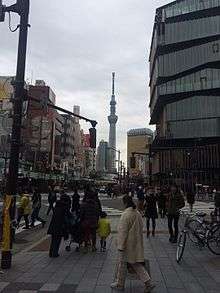 View of Skytree from Asakusa side
View of Skytree from Asakusa side - 18 December 2010: The transmitting antenna for digital terrestrial television began to be installed.
2011

- 1 March 2011: The tower topped the 600 m (1,969 ft) mark and reached a height of 604 m (1,982 ft), surpassing Canton Tower (596 m (1,955 ft)) and becoming the world's tallest tower.[34][35]
- 12 March 2011: The tower reached a height of 625 m (2,051 ft). A full inspection was made, looking for possible damage by the 2011 Tōhoku earthquake and its aftershocks.
- 18 March 2011: The tower reached its final height of 634 m (2,080 ft) at 1:34 pm JST.[36]
- 23 May 2011: Dismantling four tower cranes continues till mid-July.[37]
- 7 June 2011: Announced public opening date of Tokyo Skytree Town and entrance fee (Adults: 2,000 yen to 350 m (1,150 ft) level; extra 1,000 yen to 450 m (1,480 ft) level) to observation floors.[38]
- 17 November 2011: Guinness World Records certified the Tokyo Skytree as the tallest free-standing tower.[39]
2012
- 16 February 2012: The roofs of warehouses close to the tower were damaged by falling snow and ice from the tower.[40][41]
- 29 February 2012: Tower construction was finished. Completion was delayed two months from the original schedule because of a shortage of supplies due to the effects of the 2011 Japanese earthquake and tsunami.[42]
- 2 March 2012: A ceremony was held to celebrate the completion with a kannushi priest and 70 people from Tobu Group, construction, broadcasting and other companies.[43][44]
- 6 March 2012: First Light-up during the Tokyo Hotaru Festival
- 26 April 2012: The Emperor Akihito and Empress Michiko of Japan inspected the Tokyo Skytree Tembo Galleria.[45]
- 22 May 2012: Public opening
- 1 October 2012: Channel 9 Tokyo MX start transmission from Tokyo Skytree with continuing transmission from Tokyo Tower in simulcast manner.[46]
2013
- 16 January 2013: Snow falling from the tower knocked a hole in the roof of a nearby house. No one was injured.[47]
- 13 May 2013: Tokyo MX continue transmission from Tokyo Skytree and stopped transmission from Tokyo Tower with gradual decreasing the power since 12 November 2012.[48]
- 31 May 2013: On 9:00 a.m., formal transmission of broadcast in channel 1 to 8, except 3, start from Tokyo Skytree after number of test transmission with off for minutes to hours from Tokyo Tower since 22 December 2012.
Opening
As the Skytree's opening approached, people reportedly waited in line for a week to get tickets. By the opening, trips up the tower were fully booked for the first two months of operation.[49] The opening day drew a crowd of tens of thousands, despite rainy conditions which blocked the view from the tower's observation deck. Strong winds also forced two elevators to be shut down, leaving some visitors briefly stranded on the observation deck.[50]
According to Tobu, 1.6 million people visited Skytree in its first week. Local residents reported that the influx of visitors disturbed the peace of their community and had, so far, generated little economic benefit for the local area.[51]
Gallery
Construction progress
-

Searchlights showing the planned height of 610 m, 6 October 2007
-

The site during preparation before construction, 12 April 2008
-
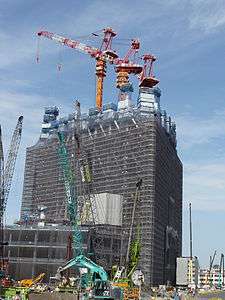
14 July 2009 (76 m)
-

19 September 2009 (153 m)
-
14 November 2009 (205 m)
-

22 December 2009 (245 m)
-
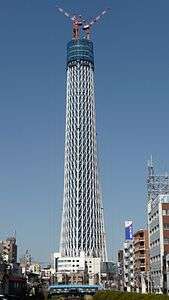
30 March 2010 (338 m)
-
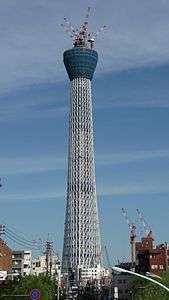
10 July 2010 (398 m)
-

Illumination testing, from 18:30 to 21:10, 13 October 2010 (488 m)
-

3 November 2010 (497 m)
-

Christmas illumination at sunset, 25 December 2010 (539 m)
-
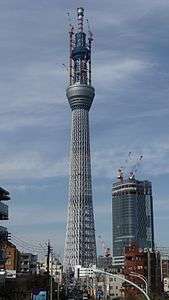
23 January 2011 (559 m)
-
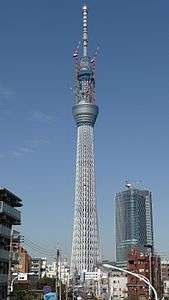
Tokyo Skytree at its full height of 634 m on 19 March 2011
-
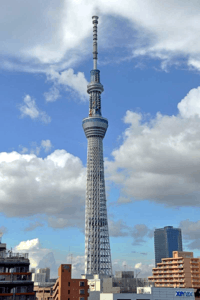
4 August 2011
-
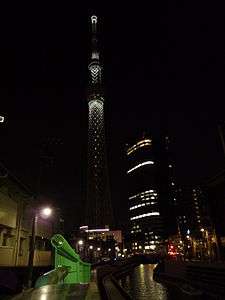
Christmas and year end illumination on 23, 24 and 31 December 2011
Observation views
See also
- Tokyo Skytree Station
- Sky City 1000
- List of tallest structures in Japan
- List of tallest freestanding structures in the world
Notes
- ↑ "Japan finishes Tokyo Sky Tree". Mmtimes.com. Retrieved 14 June 2013.
- 1 2 "Tokyo Sky Tree". Skyscraper Source Media. Retrieved November 14, 2016.
- 1 2 Tokyo Sky Tree beats Tokyo Tower, now tallest building in Japan, The Mainichi Daily News, 29 March 2010
- ↑ "Japan Finishes World's Tallest Communications Tower". Council on Tall Buildings and Urban Habitat. 1 March 2012. Retrieved 2 March 2012.
- ↑ "Tokyo Sky Tree". Emporis. Retrieved 2 March 2012.
- ↑ Arata Yamamoto (22 May 2012). "Tokyo Sky Tree takes root as world's second-tallest structure". NBC News. Retrieved 22 May 2012.
- ↑ 事業概要. Tokyo Skytree Home (in Japanese). Retrieved 2 September 2011.
- ↑ "The Tallest Tower in the World: Tokyo Skytree". TheTallestEverything.com. Retrieved 29 October 2014.
- ↑ Tokyo Sky Tree: the world’s tallest broadcasting tower. megalopolisnow (8 August 2012). Retrieved on 23 June 2014.
- ↑ Japan | ArchDaily - Part 33. ArchDaily. Retrieved on 23 June 2014.
- ↑ "Tokyo Sky Tree, Japan". designbuild-network.
- ↑ "World's tallest broadcasting tower Tokyo Skytree opens". BBC News. 22 May 2012. Retrieved 22 May 2012.
- ↑ Kyodo News, "Skytree reaches for hearts and minds", Japan Times, 25 May 2012, p. 3
- ↑ "Secrets of the Sky Tree: Quake-proofing the world's second tallest structure". Retrieved 15 April 2016.
- ↑ Nakata, Hiroko, "Tokyo Sky Tree opener looms large", Japan Times, 21 February 2012, p. 3.
- ↑ Bull, Brett, "The sky's the limit", Japan Times, 20 May 2012, p. 7
- ↑ "Color Design". Tokyo Skytree. Japan: Tobu Railway Co. 2008. Retrieved 7 June 2011.
- ↑ "Lighting Design". Tobu Tower Skytree Co., Ltd.
- ↑ Name of New Tower Decided (Japanese)
- ↑ Kyodo News, "Tower's developers considered several figures before finally settling on 634", Japan Times, 23 May 2012, p. 2
- ↑ "Tokyo Sky Tree construction starts". The Japan Times (15 July 2008). Retrieved 15 July 2008.
- ↑ 高さ610メートル電波塔「スカイツリー」本体が地上に姿 [The height of 610 meter radio wave tower, "Skytree", the main body of tower appeared on the ground]. Sankei Shimbun (in Japanese). Tokyo. Archived from the original on 6 April 2009. Retrieved 28 July 2009.
- ↑ Rising-east.jp. "Tokyo Skytree is the height of the body beyond the 100m tower. Tree is growing steadily." (PDF).
- ↑ "東京スカイーツリーの最高高さを634mに決定しました。" [Maximum height of Tokyo Skytree to be 634 m] (PDF) (in Japanese). Tokyo: Tobu Railway and Tobu Tower Skytree. Archived from the original (PDF) on 16 October 2009. Retrieved 16 October 2009.
- ↑ Archived 13 November 2009 at the Wayback Machine.
- ↑ "Tokyo Skytree's height of the tower body exceeds 300m" (PDF) (in Japanese). Rising East project. Archived from the original (PDF) on 31 March 2010. Retrieved 18 February 2010.
- ↑ "Nothing very little about this miniature". Asahi Shimbun. Japan. Retrieved 25 March 2010.
- ↑ Tokyo Skytree, already tallest building in Japan, tops 400 meters, Kyodo News, 30 July 2010
- ↑ スカイツリー、実はようやく日本一…461mに [Skytree, as a matter of fact, has finally become the tallest in Japan... 461m] (in Japanese). Yomiuri Online. 13 September 2010. (Archived by WebCite at )
- ↑ 東京スカイツリー のつくり方「制振装置のあるゲイン塔頂部をつくる」 ["To make the tower tip with TMD installed", how to make Tokyo Skytree] (in Japanese). Obayashi Corporation. 25 November 2010. Retrieved 20 December 2010.
- ↑ 総重量は約100トン。制振装置が塔体の最頂部へ [Total weight 100 ton, TMD placed on tower tip.] (in Japanese). Blog from construction site, Obayashi Corporation. 25 November 2010. Retrieved 25 November 2010.
- ↑ "Tokyo Sky Tree tops 500 meters during construction". Japan Today. 1 December 2010.
- ↑ 東京スカイツリーへの放送局の無線設備の設置に向けた変更許可について [Approval of alteration to install the radio wave facility of broadcasting stations to Tokyo Skytree] (in Japanese). Kanto Bureau of Telecommunications of Ministry of Internal Affairs and Communications. 16 December 2010. Retrieved 19 December 2010.
- ↑ "Tokyo Sky Tree tops 600 meters, becoming world's tallest tower". Japan Today. 1 March 2011.
- ↑ 世界一ツリー604メートル到達 東京スカイツリー [Tokyo Skytree reaches 604 m] (in Japanese). Nikkei Inc. 2 March 2011. Retrieved 3 March 2011.
- ↑ スカイツリー、634メートルに到達 完成時の高さに [Skytree reaches final height of 634 m]. Asahi Shimbun (in Japanese). Tokyo. Retrieved 18 March 2011.
- ↑ Yomiuri-online movie: Dismantling cranes on 23 May 2011 (Japanese)
- ↑ 東京スカイツリータウンの事業概要が決定しました [Decided the business outline of Tokyo Sky Tree Town] (PDF) (in Japanese). Tokyo Skytree Town. 7 June 2011. Retrieved 8 June 2011.
- ↑ Mirai (19 November 2011). "Tokyo Sky Tree officially tallest free-standing tower in the world". Japanverse.com. Retrieved 2 March 2012.
- ↑ Company warehouses damaged by ice falling from Tokyo Sky Tree 17 February 2012 Japan Today Retrieved 5 October 2015
- ↑ Koh, Yoree Look Up at Your Peril: Tokyo Skytree’s Falling Ice 15 January 2013 Wall Street Journal Retrieved 5 October 2015
- ↑ Japan finishes Tokyo Sky Tree, YAHOO!7 NEWS, AFP 29 February 2012, 4:07 pm
- ↑ Tokyo Sky Tree completion ceremony, 2 March 2012, Kyodo News
- ↑ 東京スカイツリーで竣工式 [Completion ceremony for Tokyo Skytree] (in Japanese). Tokyo. NHK TV. Retrieved 2 March 2012.
- ↑ "ご視察(東京スカイツリー)(墨田区) - 宮内庁" (in Japanese). Imperial Household Agency. 26 April 2012. Retrieved 12 April 2016.
- ↑ 10月1日、東京スカイツリーから放送開始 [Start broadcasting from Tokyo Skytree on 1 October 2012] (PDF) (in Japanese). Tokyo MX. 27 September 2012. Retrieved 2 June 2013.
- ↑ Snow from world's tallest tower pierces Tokyo roof 16 January 2013 Terra Daily Retrieved 5 October 2015
- ↑ "2013年5月13日18:00東京タワーの電波を中止" [Radio wave stopped from Tokyo Tower on 13 May 2–13 18:00]. Tokyo MX. 13 May 2013. Retrieved 2 June 2013In English
- ↑ Tim Newcomb (22 May 2012). "Tokyo Skytree: The World's Tallest Tower, By the Numbers". Time. Retrieved 22 May 2012.
- ↑ "High winds mar opening of Tokyo's Skytree tower". BBC News. 22 May 2012. Retrieved 22 May 2012.
- ↑ Aoki, Mizuho, "Skytree a mixed blessing for locals", Japan Times, 22 June 2012, p. 3
References
External links
| Wikimedia Commons has media related to Tokyo Skytree. |
- Official website (English)
- Tokyo Skytree live camera (Japanese)

